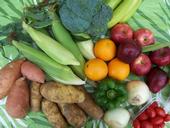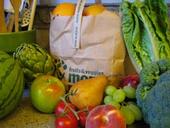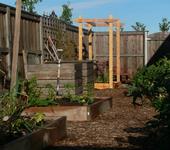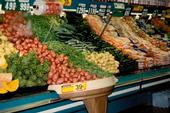- Author: Myriam Grajales-Hall

California residents not only enjoy an enviable climate and diverse regions, but also a wide selection of fresh produce year around.
As consumers, we want to stretch our food budget and provide a nutritious diet to our families; but we are not always sure about how to select the best fruits and vegetables, how to store them when we get home, new ways to serve them, and the nutrition benefits they offer.
Placer-Nevada Cooperative Extension has come to the rescue! As part of the Nutrition Best program, UCCE nutrition educators have prepared "Reasons for the...
- Author: Mary E. Reed

As you returned home from the market and unloaded your sack of produce, have you ever simply admired the satisfying bounty? Enjoyed the color, texture, and aroma as cantaloupe, broccoli, carrots, tomatoes, lettuce, cherries, apricots, avocado, strawberries and more passed through your hands? But now, what to do with each item … how best to keep it fresh and tasty until you’re ready to eat it?
The Postharvest Technology Center offers free copies of an 8.5” x 11” full color poster that shows which produce items should go in your refrigerator, which items should never go in the...
- Author: Karl Krist

Californians can take advantage of our abundant sunshine and temperate climate in order to grow fruit and vegetables they can truly call their own. Gardening has some very obvious rewards, giving gardeners the freshest fruits, vegetables and herbs possible. If you are a cook, adding a garden to your backyard will pay dividends all year long.
In order to get the greatest benefit of this fantastic produce, make sure you...
- Author: John Stumbos

Healthy eating has gotten complicated. Fresh fruits and vegetables pack the produce aisle as never before. And new food products with added health benefits are being introduced all the time. Yet the food supply, and the agricultural system that supports it, has become increasingly criticized for its impact on the waistlines of millions of people in the United States.
“Agriculture and conventional food systems have provided the basis for long and healthy lives, and much of that improvement can be traced to healthier diets,” says UC Davis plant sciences professor Alan Bennett. “At the same time, we are faced with a growing critique that conventional food...
- Author: Jeannette E. Warnert

A report released by the Centers for Disease Control in September 2009 confirms what most moms already know - high school students don't eat anywhere close to enough fruit and vegetables. According to the report, only a third get two servings of fruit a day, and only 13 percent say they get three servings of vegetables.
Adults don't have much higher marks. The CDC said only 33 percent of adults get two servings of fruit, and 27 percent three servings of vegetables.
Compare that to the recommendation in the federal dietary guidelines presented on the My Pyramid Web site. The guidelines say, for...



